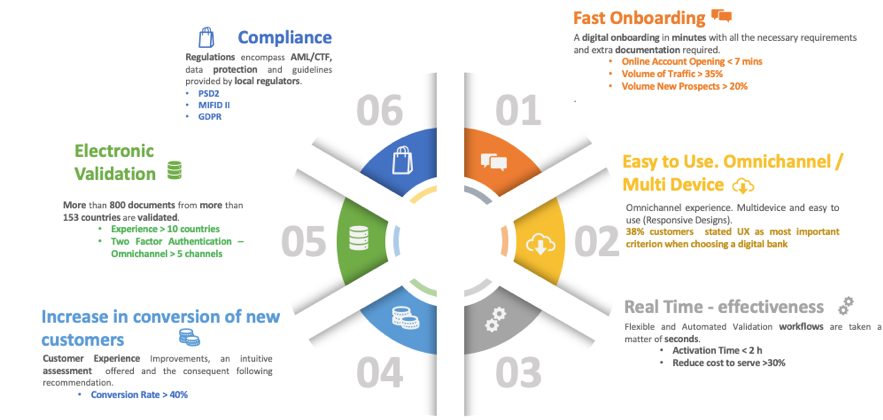Banks have undertaken large scale digital transformations to quickly adapt to changing customer behaviours.
06 May 2020
This is also driven by a continuously evolving competitor landscape such as challenger banks. As new generations become increasingly comfortable with technology, online and mobile banking are becoming essential services for people to manage their products in real time and quickly.
Digital Onboarding approach allows a unique and personalised customer experience by streamlining access to financial services while decreasing operational costs and processing time due to optimised processes
As technology evolves so do customer expectations. Users nowadays expect a high standard digital experience which is personalised and customized to their needs. Institutions that anticipate and innovate to meet these expectations will succeed in long-lasting relationships with their clients.
The vision of Omnichannel Onboarding
Onboarding Omnichannel is much more than providing multiple ways for customers to communicate, it is a consistent and predictable interaction between customers and their financial institutions across multiple channels.
Onboarding is revolutionising customer interaction in mass affluent and high net worth (retail and wealth respectively). Not only does it mean that companies no longer need to take customers through their branches to sign up for new services, but it also ensures a consistent and personalised customer experience across different channels (web, mobile, telephone, chatbots, etc).
This is also driven by a continuously evolving competitor landscape such as challenger banks. As new generations become increasingly comfortable with technology, online and mobile banking are becoming essential services for people to manage their products in real time and quickly.

Why use omnichannel in retail banking?
- 50 % of digital service applicants are under 35 years old
- 6 times a month, millennials access applications to manage their products
- 70% of customers prefer to contract products digitally
Nevertheless…
- Only 8% of the applications allow the process to start and finish on the mobile device
- 60% of all hires involve attending a branch
Today’s customers require slick and easy access to their accounts. Omnichannel banking solutions gives customers the flexibility to start their onboarding process using one channel and switch to another at any time to continue where they dropped off.
Onboarding represents one of the first customer interaction for the financial institution and will set the tone for the entire development. A move from a lengthy, paper-based and inconvenient process to a smooth and genuinely omnichannel customer experience, will succeed client expectations.
Why a financial institution needs a Digital Onboarding solution?
Digital onboarding enables significant cost reduction for financial organisations as processes can be automated. Customers are able to self-serve by simply using their phone/tablet or computer instead of calling or going to a branch.
- Enhanced customer experience. Faster and more flexible access to banking services.
– Onboarding in a matter of minutes
– Reduce paper usage
– Reduce documentation loss through e-signature
– Personalised digital user experience
– Recognised as an innovative brand - Reduced operational costs. Automate and accelerate processes such as Due Diligence, OCR, AML Screening, ECDD, KYC and POA verification- Reduce cost-to-serve
– Improve sales & service effectiveness
– Automated workflow
– Reduced human error
– Activation time is less than 2h
– Increase Assets under Management and revenues
“In the banking Industry, 38 percent of customers stated user experience (UX) as the most important principle when choosing a digital bank”.
Benefits of Digital Onboarding
Let’s see how omnichannel banking benefits in real case scenarios. We will specifically look at how this approach operates at different stages of a customer lifecycle.
1.Fast Onboarding. Opening an online account will take less than 7 minutes if a prospective customer has all necessary information and documents to hand. The volume of traffic increases up to 35% and the volume of new prospects, up to 20%.
2.Easy to Use. Omnichannel. 38% of customers stated UX as the most important factor when choosing a digital bank.
3.Real Time effectiveness. Flexible and Automated Validation workflows are taken in a matter of seconds. Activation time takes less than 2h and costs are reduced up to 30%.
4.Increase in Conversion: Due to focusing on customer experience improvements, conversion rates have risen 40%.
5.Electronic Validation. Especially in the UK, where there are many investment clients from all around the world, electronic validation is possible in more than 800 documents from more than 153 countries. Two-factor-authentication is available on all channels.
6.Compliance. The process is in line with the laws, regulations, and standards that are required for banking according to the locations in which the bank has operations. Regulations encompass AML/CTF, local regulators provide data protection and guidelines such as MIFID II, GDPR and PSD2.
Real Case Scenarios in Digital Onboarding
Let’s see how omnichannel banking benefits in real case scenarios. We will specifically look at how this approach operates at different stages of a customer lifecycle.
5.1 EXAMPLE IN SAVINGS ACCOUNT

- Collecting clients’ data and checking the accuracy of the information provided via different methods. It can be OCR (Optical Character Recognition), that extracts textual data from documents or document validation, that verifies the authenticity of the customers identity documents (such as passport, driver’s license or national ID card) scanned by customers.
- Ensuring that the customers’ identity is authenticated i.e. their identity matches the identity indicated on the documents and data has been submitted.
- Verification of the customers ID and compliance (AML- Anti Money Laundering) is performed by running background checks on static data (eg. Name, gender, nationality). Screening to “Know Your Customer”. The verification will assess the potential risks a customer could represent (i.e. counter-party risk).
- Verification of passport with Video Assistance Optical Character Recognition (OCR). Proof of address verification and additional documents.
- After verifications and GDPR consents, a digital signature is sent to customer’s email to sign off the contract. Digital checklist and welcome pack messages are sent before opening the account. Internet Banking, Auto Enrolment and credit or debit cards are ordered and activated.
“Onboarding is a specific process that requires identifying customers and verifying their identity with high level of security and low level of risk.”
5.2 EXAMPLE IN INVESTMENT BANKING

- Client identification and data capture. Customer’s ID and documents are validated. A digital signature is created, and email confirmation sent.
- KYC and AML Check. Client Verification. Perform OCR on documents to enhance user experience. OCR extracts textual data from documents or document validation and verifies the documents authenticity. AML and MIFID II Tests.
- Proof of Address: Dated bank statement/ Utility bill /Credit card statement; Letter from any recognized public authority correspondence Lease agreement along with last 3 months House purchase deed; Employer’s certificate for residence proof.
- Client Due Diligence. Gathering client’s details and Identifying and requesting relevant client documentation. Perform regulatory AML/CTF background checks. (e.g. officially list, politically exposed people, adverse media. Complete additional client ID, document checks (geographic specific) and approve it. The decision outcome is based on the nature of circumstances, reasons why and expected level of activity. ECDD (Enhanced). Negative media, source of funds, source of wealth Upload Docs (Utility bills, etc) and risk classification.
- Branching high risk clients. Lines converge as eSignature, fund allocation and welcome pack given at the end of the process.
- Compliance workflow. The electronic signature ensures that a contract is signed between the customer and the financial institution. The customer is notified with a welcome pack.
How can we help you?
At VASS, we have omnichannel solutions in more than 20 financial institutions from Commercial BanksExchange (FX), Private, Investment banks, Savings & Loans Associations, Retail Banks, to Challenger Banks and Neo Banks. Our business accelerators and experience allow us speed up Time to Market and help organisations end to end from business to IT, implementing these processes between 3 to 4 months. Our experience around the world has proven our standards in maximizing business values with the use of latest technology.
Conclusion
In the current challenging economic environment and with the increasing digitisation of the market, taking advantage of the omnichannel digital onboarding accelerator will improve any financial institution’s ability to fully enrol, convert and provide a customized digital experience to prospects and existing customers.
A structured approach is essential not just to reduce operational costs, but it is the starting point and a unique opportunity to create long-term successful relationships.


 Facebook
Facebook
 X
X
 Linkedin
Linkedin